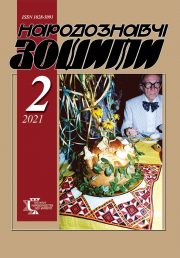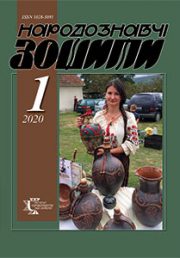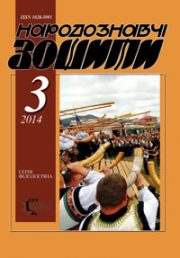The Ethnology Notebooks. 2024. № 2 (182), 466—
UDK [398.21:392.5](=161.2):[801.81:7.046](09)
DOI https://doi.org/10.15407/nz2025.02.466
MYTHOPOETIC AND MYTHOEROTIC SEMANTICS OF THE TALE «FOX AND CRANE»
TEMCHENKO Andriy
- ORCID ID: https://orcid.org/0000-0003-3999-9459
- Candidate of Historical Sciences, Associate Professor,
- Associate Professor of the Department of the Ukrainian History
- of the Bohdan Khmelnytsky National University of Cherkasy,
- 81, boulevard of Shevchenko, 18000, Сherkasy, Ukraine,
- Contacts; e-mail: temchen@ukr.net
Abstract. Introduction. Another attempt was made to decipher the hidden meanings of famous subjects of the Ukrainian traditional fairy tale.
The purpose of the publication is to identify the mythological implications of fairy -tale images of chanterelles, cranes, wolf, cat as semantically dynamic characters that embody different levels of mythological universe and present generally accepted social norms of customary law.
The research methods meet the goal and tend to analyze, compare and synthesize different concepts related to the reconstruction of the mythological context of the fairy tale.
The results obtained. The Ukrainian fairy tale «Fox and Crane» is a rudiment of mythological discourse, so it has a complex semantic configuration. The first content marker concerns the archaic picture of the world, which seems to be a juxtaposition of the mythological top of the neb (crane) and the chronic bottom-land (chanterelles). Hence the positive and negative concepts of fairy tales, which are protruding on the situations of everyday life. In particular, dual values acquire semantic concretization and relate to the relationship of «male» and «female», where crane denotes parity relationships, which with «great friendliness» can develop into opposite as a result of violation of an important rule of harmonious coexistence — physiological and psychological incompatibility. The chanterelle, not receiving the desired from the crane, stops a relationship that demonstrates opposite estimates of similar situations, where the wrong actions of a man are interpreted as unacceptable, and his refusal is perceived as an insult for a woman. The corresponding stereotypes are of ancient origin and are explained by the existence of an indisputable rule, according to which a woman had the right to choose a husband — the future father for her children.
Instead, the situation with the wolf is different because it is subjected to constant manipulation of the chanterelle. The semantic architectonics of the fairy tale exposes a number of behavioral stereotypes. The fairy tale leitmotif is the desire of the chanterelle to get the maximum benefit of a naive wolf.
In addition to psychological content, the plot of the fairy tale is full of erotic symbolism, tangent to wedding folklore. In the context of the fairy tale, additional binary oppositions with the symbols of «male» and «female» are formed, in particular: «jug — bowl», «heron — skovoroda», «wolf tail — hole». In parallel in the fairy tale, they prevail with the symbolism of mating and fertilization, which indicates ambiguous images of «porridge», «fish» and «poppy seeds».
Keywords: God’s messenger, wedding, jug, pot, wolf, childbearing organ, erotica, frog, woman, crane, hare, snake, fairy tale, cat, chicken, stork, fox, poppy, myth, tunnel, young man, pies, behavior, fish, sex, frying pan, gender, stereotype, plate, heron, man, tail.
Received 17.03.2025
REFERENCES
- Kis, O. (2002). Ethnic Gender Stereotypes and Sources of their Design. Magazine. Ukrainian Women’s Movement: Achievements and Problems: Collection of scientific works (Issue 1, pp. 26—43). Drohobych: Kolo [in Ukrainian].
- Kis, O.R. (2012). A Woman in the Traditional Ukrainian Culture of the Second Half of the Nineteenth and Early Twentieth Centuries (Pp. 76—233). Lviv: Institute of Ethnology of NAS of Ukraine. Retrieved from: https://irbis-nbuv.gov.ua/ulib/item/ukr0000024325 (access date 03.03.2025) [in Ukrainian].
- Nestertsova-Sobakar, O.V. (2005). Features of the Legal Status of Ukrainian Women under the Civil Law of the Russian Empire in the Second Half of the Nineteenth and Early Twentieth Century. Scientific Bulletin of the Law Academy of the Ministry of Internal Affairs: Collection of scientific works, 1 (20), 110—117 [in Ukrainian].
- Havrylyuk, E. (1999). Erotic Implications of Plant Symbolism in the Ukrainian Calendar. Ritual. Integral Culture Study Studios (Pp. 32—55). Lviv. Retrieved from: https://svarga.com.ua/erotichni-implikacziii.html (access date 12.02.2025) [in Ukrainian].
- Buryak, L. (2011). Woman in Ukrainian Society: Historical Studies of the Second Half of the Nineteenth Century — the Beginning of the Twentieth Century. Ukrainian Almanac (Issue 6, pp. 67—71). Retrieved from: http://irbis-nbuv.gov.ua/everlib/item/er-0003145 (access date 03.03.2025) [in Ukrainian].
- Sokil, H. The Image of a Woman in Ukrainian Ceremonial Songs: Functional Direction, Traditional Meanings. Retrieved from: https://bibliotekanauki.pl/articles/55678943 (access date 03.03.2025) [in Ukrainian].
- Mayerchyk, M. (2011). Ritual and Body: Structural and Semantic Analysis of Family Cycle Rites. Ukrainian Institute of Harvard University; National Academy of Sciences of Ukraine: Institute of Folklore; Institute of Criticism; Center for Cultural and Anthropological Studies. Kyiv: Krytyka [in Ukrainian].
- Krasikov, M.M. (Ed.). (2003). Ukrainian Shameful Songs. Kharkiv: Folio. Retrieved from: https://proridne.com/content/%D0%BF%D1%96%D1%81%D0%B5%D0%BD%D0%BD%D0%B8%D0%BA%D0%B8/%D0%A3%D0%BA%D1%80%D0%B0%D1%97%D0%BD%D1%81%D1%8C%D0%BA%D1%96%20%D1%81%D0%BE%D1%80%D0%BE%D0%BC%D1%96%D1%86%D1%8C%D0%BA%D1%96%20%D0%BF%D1%96%D1%81%D0%BD%D1%96/#m01 (access date 07.02.2025) [in Ukrainian].
- Krasikov, M. A Relevant Shame. Retrieved from: https://localhistory.org.ua/texts/statti/dorechna-soromichchina/ (access date 07.02.2025) [in Ukrainian].
- Ignatenko, I., & Oprysko, O. (2014). «Ideal Woman»: an Idea of Women’s Beauty in the USSR in the 1920s—1930s. Ethnic history of the Peoples of Europe (Issue 42, pp. 178—183). Retrieved from: http://nbuv.gov.ua/UJRN/eine_2014_42_28 (access date 03.03.2025) [in Ukrainian].
- Ignatenko, I. (2023). Body, Sex, Marriage. History of Intimate Relations in Ukrainian Traditions. Kyiv: Vihola [in Ukrainian].
- Ukrainian Folk Tales. Retrieved from: https://kazky.org.ua/ zbirky/ukrajinsjki-narodni-kazky (access date 03.01.2025).
- Beliefs Related to White Stork. Retrieved from: https://uncg.org.ua/projects/zaluchennya-gromadskosti/leleka/viruvannya/ (access date 21.01.2025) [in Ukrainian].
- Karabovych, T. (2019). Folk Customs for the Annunciation. Our word, 14. Retrieved from: https://nasze-slowo.pl/narodni-zvichayi-na-blagovishhennya/ (access date 15.03.2025) [in Ukrainian].
- (1895). Materials for the Dictionary of the Old Russian Language According to Written Monuments. I.I. Sreznevsky’s Work Edition of the Department of the Russian Language and Literature of the Imperial Academy of Sciences: in 3 vol. (Vol. 2). St. Petersburg: Printing house of the Imperial Academy of Sciences [in Russian].
- Bagmut, J., Bobkova, V., & Bagmut, A. (1963). Ukrainian Folk Proverbs and Sayings: Pre-October. Kyiv: State Publishing House of Fiction [in Ukrainian].
- Humenna, D. «Gift of Euthodei». Retrieved from: https://www.ukrlib.com.ua/books/printit.php?tid=14293 (access date 12.02.2025) [in Ukrainian].
- Havrylyuk, E. (1999). Erotic Implications of Plant Symbolism in the Ukrainian Calendar. Ritual. Integral Culture Study Studios (Pp. 32—55). Lviv. Retrieved from: https://svarga.com.ua/erotichni-implikacziii.html (access date 12.02.2025) [in Ukrainian].
- Zadorozhny, V. (2013). The Symbolism of the Ukrainian Folk Rite of Wedding. Mythology and Folklore, 2—3, 88—99. Retrieved from: http://publications.lnu.edu.ua/journals/index.php/mythology/article/viewFile/731/732 (access date 07.02.2025) [in Ukrainian].
- Trotska, V. (2019). From the History of Studying the Range of Clay Utensils of the Day of Russia. Ethnic History of the Peoples of Europe, 29, 100—111. Retrieved from: https://chtyvo.org.ua/authors/Trotska_Valentyna/Z_istorii_vyvchennia_asortymentu_hlynianoho_posudu_doby_Rusi.pdf (access date 05.02.2025) [in Ukrainian].
- Trotska, V. (2017). History of the Study of Clay Utensils of the Kiev-Rus Era in the Territory of Ukraine. Sivershchyna in the History of Ukraine (Issue 10, pp. 96—100). Retrieved from: http://dspace.nbuv.gov.ua/bitstream/handle/123456789/128611/24-Trotskaya.pdf (access date 05.02.2025).
- Trotska, V. (2010). From the History of Studying the Use of Clay Products in Customs and Rituals in Rus in the X—XIII Centuries. Ethnic History of the Peoples of Europe (Issue 31, pp. 55—61). Retrieved from: http://nbuv.gov.ua/UJRN/eine_2010_31_9 (access date 07.02.2025) [in Ukrainian].
- Shcherban, O.V. (2017). The Evolution of Traditions of Use of Clay Utensils in the Folk Culture of Nutrition of Ukrainians of the Dnieper region of the Second Half of the Nineteenth and Early Twenty First Centuries. Dissertation for the degree of Doctor of History in the specialty 07.00.05 — Ethnology. Institute of Ukrainian Studies. I. Krypiakevych NAS of Ukraine; Institute of Ethnology of NAS of Ukraine. Lviv. Retrieved from: https://chtyvo.org.ua/authors/Scherban_Olena/Evoliutsiia_tradytsii_vykorystannia_hlynianoho_posudu_v_narodnii_kulturi_kharchuvannia_ukraintsiv_Na.pdf (access date 07.02.2025) [in Ukrainian].
- Chubynsky, P.P. (1995). Wisdom of the Ages. Ukrainian Folklore in the Creative Heritage of Pavlo Chubynsky: in 2 vol. (Vol. 1). Kyiv: Mystetstvo [in Ukrainian].
- Temchenko, A. (2021). Mythosemantics and Mythos of Folk Picture «Cossack with a Girl near the Well». Materials for Ukrainian Ethnology, 20 (23), 118—125. Retrieved from: https://mue.etnolog.org.ua/2021-rik/20-23/2451-z-istoriyi-ta-teoriyi-ukrayinoznavchykh-studiy/5462-mifosemantyka-i-mifosiuzhetyka-narodnoi-kartyny-kozak-z-divchynoiu-bilia-krynytsi (access date 15.03.2025) [in Ukrainian].
- Kurochkin, O.V. Archaic Wedding Dance-Game «Crane» («Busel»). Scientific Proceedings. Theory and History of Culture (Vol. 20—21, pp. 71—75). Retrieved from: https://ekmair.ukma.edu.ua/bitstream/handle/123456789/8614/Kyrochkin_Arxayichnyj_vesilnyj_tanecz.pdf (access date 02.02.2020); https://ekmair.ukma.edu.ua/bitstreams/4717c577-6222-409b-8ede-fbb7fae8af7b/download (access date 24.01.2025) [in Ukrainian].
- Makhovska, S. (2011). Wedding Traditions of the Ukrainian-Russian Border (According to the Field Research of the Villages of Luhansk Region). Folk Creativity and Ethnography, 1, 99—105. Retrieved from: http://dspace.nbuv.gov.ua/bitstream/handle/123456789/43301/14-Makhovska.pdf?sequence=1 (access date 03.03.2025) [in Ukrainian].
- Kovalenko, N. (2018). Ornitonomy of the Stork in Modern Ukrainian Dialect Speech. Philological Journal (Issue 2 (12), pp. 43—49) [in Ukrainian].
- (1930). Yakov Demchenko’s Ethnographic Records 1857—1858. Ukraine (Book 1, pp. 89—129) [in Ukrainian].
- Stavytska, L. (2008). Ukrainian without Taboo. Dictionary of Obscene Vocabulary and its Correspondences. Kyiv: Criticism [in Ukrainian].
- Veletskaya, N. (1978). The Iconic Symbolism of the Slavic Archaic Rituals. Publishing house: «Science». Retrieved from: https://pda.coollib.net/b/57656/read (access date 24.01.2023) [in Russian].
- Zubyk, L. (2021). The Role of «Fun at the Dead» in the Ritual Process of the Funeral in Hutsuls. Lukomorye Antiquity. Retrieved from: https://www.researchgate.net/publication/358153218_Rol_zabav_pri_merci_v_ritualnomu_procesi_pohoronu_u_guculiv (access date 24.02.2025) [in Ukrainian].
- Hrusheva, T.V. (2017). Social Status of Women in Soviet Ukraine in the 20—30’s of XX century. Scientific works of the Faculty of History of Zaporizhzhya National University (Issue 47, pp. 119—123). Retrieved from: http://nbuv.gov.ua/UJRN/Npifznu_2017_47_24 (access date 03.03.2025) [in Ukrainian].







